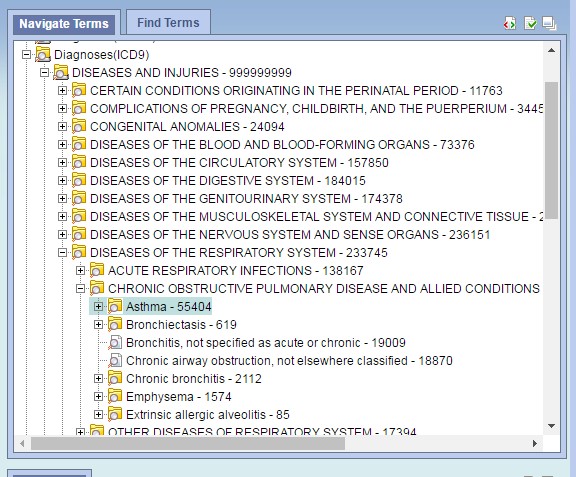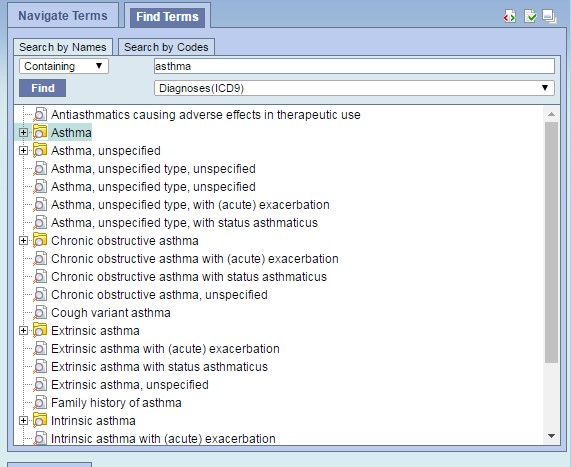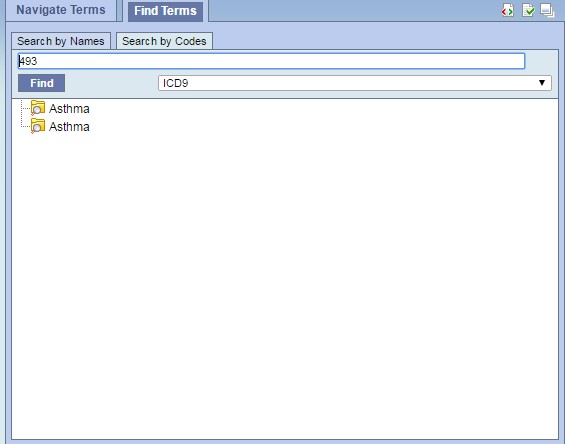Ontologies
BU-i2b2 has an extensive list of ontologies to organize the extensive data in the system.

Admissions: This ontology uses the DRG (Diagnostic Related Group) codes. The DRG system classifies inpatient stays for the purposes of payment. Diagnoses are grouped into more than 20 major body systems and subdivided into almost 500 groups for the purpose of Medicare reimbursement. More information about DRG codes can be found here.
Clinical Ontologies are groups of codes mapped from diverse clinical data in the EHR to a standard set of codes in i2b2. Currently the only clinical ontology supported in BU-i2b2 is tobacco smoking status within the “Substance Use” ontology. We plan to expand the available ontologies in the future.
Demographics: This ontology organizes demographic concepts like race, ethnicity and gender. The ontology also has a concept called “age” however it should be noted that the age used is the age at the time the data was last refreshed (i.e. the age the patient is now) so should be used with caution.
Diagnoses (ICD 9/10) – International Classification of Disease codes are used to classify diagnoses. Between 2000 and 2015 the ICD9 codes were used. Beginning in late 2015 coding was changed to ICD10. In general ICD10 codes are more specific than ICD9 codes but both ICD9 and 10 codes can used in i2b2 queries. In BU-i2b2 all concepts can have a beginning and end date as well as a value. Diagnoses in BU-i2b2 have different values based on where the code came from. ICD9/10 codes from an EHR Problem List are assigned the value “Problem”, codes from billing systems (diagnoses made on a particular day) are assigned “Primary, Secondary, or Unknown” depending on the order of the diagnosis in the billing systems. Diagnoses assigned to hospital admissions are assigned the value of “Admitting”. To learn more about ICD9/10 click here.
Drug Products by VA Class – This ontology organizes medications prescribed within the EHR. RxNorm codes are used in this ontology. RxNorm codes are a common standard for medication coding and are simpler to use than NDC codes. For more information on RxNorm click here.
GE Centricity/ New – BMC and its affiliated health centers used the GE Centricity EHR between 2000 (BMC) and 2003 (CHCs) and 2015. This EHR provided a library of concepts that could be used in form to capture structured data. The codes (HDID codes) are unique to this vendor and not standardized. However a rich set of data that includes labs, vital signs, answers to structured questions, and a wide variety of other data are available in HDID codes. However, the codes are not standardized and are organized in alphabetical order. A complete list of HDID codes and definitions from the GE library for BU-i2b2 are available in an excel spreadsheet.
GIS – This ontology organizes the zip codes and census tract codes for patients at the time of visits. The codes are organized by county and neighborhood.
Immunizations (Epic) – This ontology organizes immunizations using CVX codes. CVX codes are the national immunization codes and are supported by the Centers for Disease Control. For more information about CVX codes click here.
Insurance by Payer – This ontology organizes the insurances recorded at the time of visits. Insurances are grouped by category (Commercial, Medicaid, Medicare, etc) and type (Medical, Dental, Behavioral Health, etc).
Laboratory Tests – Reference (LOINC) and LabsCommonName (Epic). LOINC (Logical Observations Identifiers, Names, Codes) is a standard code system for reporting laboratory and other clinical observations. For more information on LOINC click here.
Procedures (CPT) and Procedures (ICD) – These ontologies organize procedures done using CPT codes and ICD9/10 procedure codes. For more information about CPT codes and more information about ICD9/10 procedure codes click here.
Services by Department and Services by Location – This ontology organizes the visit location codes at each site using an ontology developed by researchers at BMC. Inpatient, Observation, and Emergency Room visits are not independant of specialty involved while ambulatory visits (Outpatient (OP)) are organized by specialty. The Services by Department ontology organizes all services for a certain department regardless of location (for example, all visits to Family Medicine regardless of site). The Services by Location ontology organizes services first by location and then by department (for example, all visits to Family Medicine at a particular site).
Navigating Ontologies
These ontologies can be explored, and concepts selected, in two ways. The first way is to use the folders to navigate what it is you’re looking for in the Navigate Terms Tab. Folders are expanded and concepts identified by “drilling down.” The example below shows how a researcher could identify the “Asthma” diagnosis folder as well as individual diagnoses within that folder.

The second way involves using the Find Terms tab. concepts can be searched for by name using the Search by Names tab or by the actual code using the Search by Codes tab. The example below shows how a user could find the diagnosis codes for asthma by name or ICD9 code.

